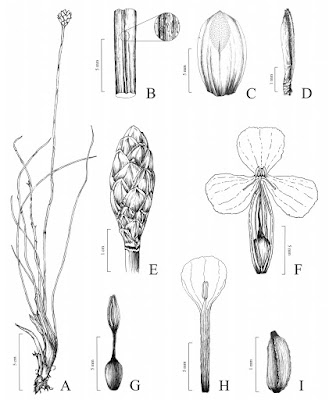 |
| Xyris desquamatus J.R.Morel & Munzinger in Morel & Munzinger. 2021. |
Abstract
Three endemic species of Xyris (Xyridaceae, Poales) are currently recognized in New Caledonia. A recent multivariate analysis of 18 morphological characters based on 129 specimens of Xyris from New Caledonia, supported by 10 anatomical and micromorphological observations, suggested that three species should be recognized in the New Caledonian archipelago. However, the three published names did not correspond to the three entities identified via the multivariate analyses. The results showed that Xyris neocaledonia Rendle was morphologically distinct but requires lectotypification, Xyris guillauminii Conert was indistinct from X. pancheri Rendle, and that a new morphologically distinct species required description. We therefore propose to clarify the taxonomy of the genus for New Caledonia, by designating a lectotype, making this synonymy and describing the new species. The new species, Xyris desquamatus J.R.Morel & Munzinger, sp. nov., has the remarkable feature of leaves that are shed as the plant senesces, and is reflected in the specific epithet for this new species. Line drawings are provided for the new species, along with colour photos for the three New Caledonian Xyris species and a distribution map. Three identification keys are provided, the first based on vegetative characters, the second on reproductive characters and the third on anatomical features of the leaf. Xyris desquamatus is preliminarily assigned an IUCN risk of extinction assessment of vulnerable.
Keywords: Taxonomy, anatomy, Flora of New Caledonia, lectotype, conservation, Monocots
Xyris desquamatus J.R. Morel & Munzinger, sp. nov.
Diagnosis—Differs from X. pancheri in having junciform and terete leaves (13–50 x 0.1–0.3 cm) (versus linear and elliptic in cross-section), which peal away and become ribbed at senescence (versus remain entire), staminodes reduced to filaments (versus staminodes developed and densely feathery), presence of palisade parenchyma and collenchyma (versus absence) and a thickening of the medullary parenchyma (versus no thickening) before its disintegration to form a thatch.
Etymology:—The epithet desquamatus refers to the peeling of leaves and stipes at senescence.
Jérémie Morel and Jérôme Munzinger. 2021. Novitates neocaledonicae. XIII. Taxonomy and Nomenclature of the Genus Xyris (Xyridaceae, Poales) in New Caledonia, with Description of A New Species. Phytotaxa. 502(3); 219–229. DOI: 10.11646/phytotaxa.502.3.1

